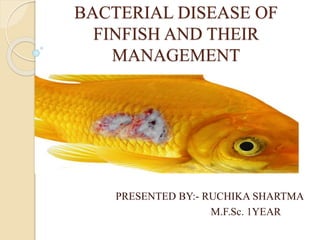
Bacterial Diseases of Finfish and Their Management
- 1. BACTERIAL DISEASE OF FINFISH AND THEIR MANAGEMENT PRESENTED BY:- RUCHIKA SHARTMA M.F.Sc. 1YEAR
- 2. Furunculosis Disease(Gram negative bacterial infection) Causative Agent:- Aeromonas salmonicida(obligate pathogen) Symptoms:- In old fish lethargy, slight exophthalmia blood shot fins, bloody discharge from the nares and vent, and multiple haemorrhages in the muscle and other tissues. Internally, haemorrhages in the liver, swelling of the spleen, and kidney necrosis may occur. In growing fish and adults- darkening in color, lack of appetite, lethargy and small haemorrhages at the base of fins. Affected fish may die within 2-3 days and causes high mortalities.
- 3. Control measures:- Adequate husbandry practices such as maintenance of good water quality, disinfection of fish farm where outbreaks occurred and routine disinfection for eggs. Stocking of fish farms with disease-resistant strains of fish and the development of effective vaccines also improve the health of fishes and use of antimicrobial compounds. Treatment:- Chemotherapy used:- Sulphamerazine given orally with feed at a dose of 22 g of drug / 100 kg of fish / day. Chloramphenicol and oxytetracycline were dosed 5-7 g / 100 kg of fish / day. Vaccines have been used to prevent the furunculosis successful.
- 4. Haemorrhagic septicaemia(Gram negative bacterial infection) Causative Agent:- Aeromonas hydrophila Symptoms:- Small surface lesions, local haemorrhages particularly in the gills and vent, ulcers, abscess, exophthalmia and abdominal distension. Internally, there may be accumulation of ascitic fluid , anemia and damage to the organs, notably kidney and liver.
- 5. Red sore disease:- caused by A. hydrophila, characterized by erosion of the scales and pin-prick haemorrhages which may cover up to 75% of the body surface with a high mortality rate. Treatment:- Chemotherapy used- chloramphenicol and nifurpirinol, oxytetracycline and sulpham-erazine have been used. A polyvalent vaccine would be necessary for combating this disease.
- 6. Pasteurellosis Disease Causative Agent:- Pasteurella piscicida Symptoms:- The affected fish show prominent white granules in the kidneys and spleen. Pasteurellosis is one of the most important bacterial disease among young cultured marine fish in Japan.
- 7. Control measures:- Avoidance of over crowding and feed management may prevent out-breaks of this disease. Ampicillin, amoxicillin, novobiocin, chloramphenicol florfenicol, oxolionic acid, flumequin and sodium nifurstyrenate are used to control bacterial pseudotuberculosis.
- 8. Edwardsiella septicaemia Causative Agent:- Edwardsiella tard Symptoms:- This disease occurs in the summer months with an optimum temperature of 300 C. The diseased fish hang listlessly at the surface with a head-up-tail down position, sometimes spinning rapidly increased, usually followed by death. Hemorrhage or inflammation occurs in the skin under the jaw on the opercula and belly. The kidney and spleen are enlarged and spleen is dark red.
- 9. In chronically infected fish, an open lesion will develop between the frontal bones of the skull, posterior to or between the eyes. Affected fish have pale gills, exophthalmia and often an enlarged abdomen. Internally, the body cavity may be filled with a cloudy, bloody or rarely a clear yellow fluid. Control measures:- The use of antibiotics incorporated into the feed. Oxytetracycline and a potentiated sulfonamide are the only drugs currently in use. Since the appetite of the fish in lost after some time the medicated feed should be given early in the epizootic.
- 10. Bacterial Gill Disease Causative Agent:- Yellow pigmented bacteria (YPB) {cytophaga-like bacteria (CLB)} Symptoms:- Affected fish become lethargic and anorexic, they tend to remain near the surface or inlet and may be observed flaring their opercula and coughing their respiratory rate is elevated and mucous secretion may increase. Early stages include hyperemia, swelling of the primary lamellae and increased mucus secretion which traps debris.
- 11. Control measures:- Environmental quality should be maintained by avoiding over crowding, low dissolved oxygen, suspended solids and high ammonia levels. Treatment:- Use of 1-5%, NaCl2 for 1-2 minutes.
- 12. Vibriosis Disease Causative Agent:- V. anguillarum Symptoms:- Occurs in warm weather, when the stocking densities are high and salinities and organic loads are also high. Signs of the disease are anorexia, with darkening of whole fish or particular areas. Gills are pale and fibrinous adhesions occur between visceral and parietal peritoneum. The eye may get infected and ulcerated.
- 13. Severe necrosis of muscle with internal ulceration occurs. In the liver, there is focal necrosis and in the spleen and kidney, massive depletion and necrosis of hematopoietic elements. Control measures:- Maintenance of water quality, good husbandry and low stocking densities. Vaccines administration is by injection, oral and immersion method.
- 14. Streptococcosis Disease Causative Agent:- Streptococcal septicemia Symptoms:- Erratic swimming, darkening of body color, unilateral or bilateral exophthalmia, corneal opacity, hemorrhages on the opercular and the base of the fins Ulceration of body surface.
- 15. Control measures:- Fluorescent antibody technique is the most rapid and effective method for diagnosis of streptococcal infection. Reducing over crowding, overfeeding, unnecessary handling or transportation and the prompt removal and slaughter of all moribund fish in ponds or net cages at an early stage of infection may prevent outbreaks or reduce their severity. Treatment:- Erythromycin given at does of 25-50 mg / kg body cut of fish / day for 4-7 days.
- 16. Mycobacteriosis Diseases Causative Agent:- M. marinum, M. fortuitum and M. Chelonae Symptoms:- Lightlessness, anorexia, emaciation, dyspnoea, exophthalmia skin discoloration and external lesions ranging from scale less to nodules, ulcers and fin necrosis as signs of advancing infection.
- 18. Control measures:- Natural spread of infection within a closed environment may be controlled in the tank by the adding of chloramine B or T at 10 mg/litre for 24 h after which the water should be changed.